This is perfectly possible, and could lead to major repercussions on the climate of the coastal zones close to the currents involved. Indeed, the main oceanic currents are not indifferent to the climatic conditions of the zones they cross, and we know through the study of past climates, moreover, that some of these currents are much less stable than it seems : the Gulf Stream, for example, underwent major modifications a number of times in the past 100.000 years.
There are two main categories of marine currents :
- The large scale horizontal circulation, generally put in motion by winds, that includes the Gulf Stream and the Labrador Current (among others) in the Northern Atlantic, and which is the one that we generally see drawn on maps.
- Currents that go from the deep ocean to the surface then dive back to the depths. They are put in motion by differences of temperature (cold water is more dense than warm water) and of salinity (salt water is denser than fresh water) between the different layers of the ocean : when the horizontal circulation puts some dense water above some not as dense water, the denser water on top plunges and generates a vertical circulation. The deepest circulation of this type is called thermohaline circulation (see below), and another one that doesn’t go as deep is named thermocline circulation. It is easy to see that the radical “thermo”, that designates heat, can be found in both these words.

Simplified panorama of the various vertical circulations happening between the surface and the deeper layers of the ocean, with the duration of the whole cycle (that is the time needed for a molecule of water to come back to the same place after having been all the way round). “Photic Zone” designates the upper layer that receives sunlight (the first 100 metres, more or less).
Source : IPCC, 1996
One of these currents is particularly important for the world ocean : it is the deep water formation in the Norway and the Labrador Seas during the winter (of the Northern Hemisphere, let’s be precise for those that would be tempted to put Norway between the Philippines and Indonesia). The surface water that goes polewards in the Northen Atlantic, by the means of the Gulf Stream, becomes more and more salted because of evaporation (part of the water that evaporates falls back on the ocean, of course, but another part falls back on continents and is returned to the ocean only “later”) and gets cooler and cooler because it looses heat to the neighbouring continents, each of these processes contributing to make this water denser.
When winter comes near the North Pole, part of the salt dissolved in the sea water that freezes to form sea ice is expelled, and enhances further the salinity of the sea water that doesn’t freeze, which then becomes so dense that it plunges towards the ocean depths.
The capital point is that surface currents and this deep water formation in the Norway and Labrador Seas are interconnected : this thermohaline circulation is one of the “engines” of the global oceanic circulation, and “sucks up” the Gulf Stream far north, what is illustrated with the little figure below.

This drawing represents the global oceanic circulation, that mixes together the waters of the various oceans of the globe and the various layers of the ocean.
There are only two places in the world where there is a deep water formation : for the most part in the Norway and Labrador Seas, near Greenland, and for a little part near the Antarctic, in the Wedell Sea.
Image from “Système Terre”, of Ichtiaque RASOOL, Flammarion, 1993
It happens that these vertical circulations (another expression being convective currents) are very sensitive to small regional temperature variations. For example, one of the first stages of the El Niño process is a modest warming (2 to 3°C) of the surface temperature of the eastern Pacific, and this is enough to alter the thermocline circulation there, with significant consequences on the fish abundance, and major incidences on the climate of the Andean countries.
Incidentally, this temperature increase is also enough to generate various catastrophes that happen thousands kilometers away, what illustrates all the difficulty that there is in predicting accurately the magnitude and the localization of the consequences of the global warming in progress.
If we come back to currents, a perturbation of the thermohaline circulation might perfectly happen in the future. We have seen that :
- the warming will be particularly important near the North Pole, and might therefore impact significantly the surface temperature of the Norway and Labrador seas, and if the water there warms up it becomes less dense,
- sea ice must be formed in order to free a surplus of salt that suddently enhances the density of surface water, and if the making of sea ice becomes more and more difficult in the future there will be less (or not at all) extra salt available,
- climate change should include an increase in pluviometry in the high latitudes (particularly in Northern Europe and Canada), what shoud then increase the amount of freshwater poured into the Northern Atlantic, without an additional evaporation being sufficient to balance it. All this could lead to a decrease of the salinity, and therefore of the density, of the surface water at these latitudes.
These three processes could reduce, or suppress, the deep water formation in the Norway Sea, and the whole world circulation could be destabilized as a consequence.
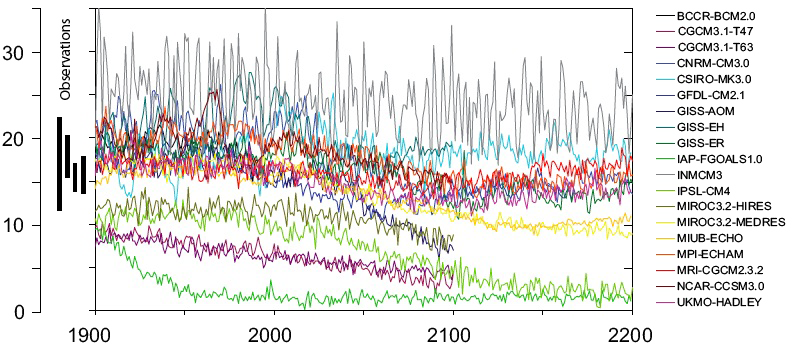
Simulated evolution of the Northern Atlantic water flux (called overturning), in Sv (Sv stands for Sverdrup ; 1 Sv = 1.000.000 m3/s), depending on the models (designated by barbarian abreviations !), for the 1900-2200 period. The emission scenario is A1B until 2100, then the greenhouse gases concentration is held constant until 2200..
The present flux is 12 to 25 Sv (this bracket correspond to the vertical black bars on the left, below “observations”).
Simulations that predict an abrupt shutdown of the overturning before 2100 are not consistent with present day observations. The most pessimistic simulations among those that are consistent with present day observations predict a decrease up to 60% of the present overturning.
Over 2100, some simulations predict a reverse evolution (overturning increases again) while some other predict a stable state with a much lower flux than today.
Source : IPCC, 4th assessment report, 2007
Are we really at risk of suppressing or slowing down the Northern Atlantic circulation ? Well, if this question is so often asked, it is simply because such a shutdown happened many times during the last glacial age (-120,000 to -20,000 years before present, roughly), and even during the last deglaciation : the last episode of circulation massive slowdown happened 8,000 years before present.
The cause of these slowdowns has been most often some gigantic release of icebergs from Greenland or the present Canada (hence their happening during ice ages), that brought considerable quantities of freshwater in the Atlantic, what quite suddently stopped the deep water formation in the Norway and Labrador Seas for the reasons exposed above. The last episode (8,000 years before present) had a different cause : the sudden discharge of a gigantic freshwater lake that formed over Canada as a result of the melting of part of the Laurentide ice cap (the Laurentide was the ice cap that covered Canada during ice ages) during the last deglaciation.
In all cases, the succession of events has been the same : a supplementary supply of freshwater in the Northern Atlantic prevented the deep water formation, which in turn generated a major slowdown of the Gulf Stream, because this thermohaline circulation (actually the deep water formation) acts as a kind of giant “suction pump”, that attracts surface water to the most northern part of the Atlantic.
This slowdown of the Gulf Stream then resulted in a massive decrease of the temperatures over Europe and Northern America (5 to 6°C of diminution of the annual mean), that happened in a couple of decades only. These processes have been baptised “climatic surprises” and have profoundly destabilized the conditions for living beings on both shores of the Atlantic at the time.
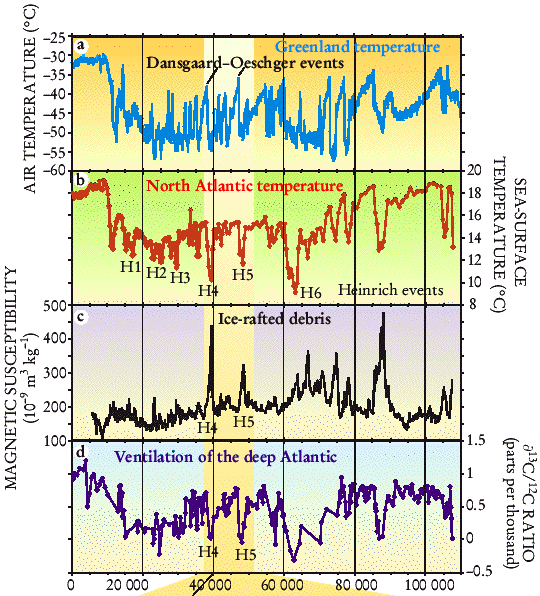
Abrupt temperature changes that happened during the last 100.000 years, and a couple of consequences and explanations.
- The curve on top (Johnsen et al., 2001) shows the average near surface air temperature over Greenland , reconstructed from the proportion of oxygen 18 or deuterium in the ice (explanations can be found on this other page of the website). It shows brutal variations of 15 to 20 °C of this average temperature over Greenland. Brutal heatings are called Dansgaard-Oeschger events, after the name of the two scientists that first discovered them.
- The middle curve (Bard et al., 2000 ; Pailler & Bard, 2002) shows that at the same time there have been variations of 5 °C or more of the average sea surface temperature of the Northern Atlantic. Rapid coolings are named Heinrich events. Temperatures are reconstructed from the conformation of specific molecules – alkenones – found in the marine sediments, and that come from algae that lived near the surface. It happens that the chemical bonds of these molecules are not the same depending on the sea surface temperature at the time the algae lived there ; the analysis of these bonds therefore allows to reconstruct past temperatures.
- The third curve from the top (Thouveny et al.) shows that most these abrupt coolings are contemporary to an accumulation on the bottom of the ocean of “ice rafted debris”, that came from continents. These debris are little stones that got encrusted in the bottom of the glaciers of Greenland or the Laurentide (a huge ice cap that covered what is now Canada) and that remained “glued” to the bottom of the ice there when the extremities of these glaciers expelled icebergs to the sea. These “debris” then progressively fell to the bottom of the ocean while ice was melting. When there is no massive expulsion of icebergs, the proportion of such debris in the marine sediments is therefore much lower.
- The last curve above (Shackelton et al., 2000) shows that the ventilation (that is the oxygen supply) of the deep Atlantic underwent an important decrease at the same time. This ventilation is reconstructed bu analyzing the respective proportion of carbon 12 and carbon 13 in the marine sediments, knowing that depending on the available oxygen in the depths, little animals that live in the deep ocean include more or less carbon 13 in their shells. This decrease of the ventilation suggests a slowing down of the deep ocean circulation (the one deriving from deep water formation), precisely providing oxygen to the depths.
From E. Bard, Climate Shock : Abrupt Changes over Millennial Time Scales, Physics Today, december 2002 (article pretty accessible to profanes, hence highly recommended to anybody who whishes to “know more”).
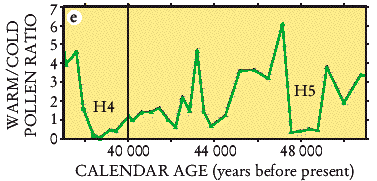
Warm/Cold pollen ratio for the last 50.000 years.
This curve (Sanchez & al. 2000) shows that the rapid cooling of the sea surface temperature, resulting from the Heinrich events (the massive iceberg expulsions) happened over the continents at the same time (for example H4 at roughly -38,500 years before present, or H5 at roughly -48.000 years before present, that can also be seen on the previous figure). The pollen dating from that time (found in lacustrine sediments) has very quickly changed of nature (warm/cold pollen ratio means the respective proportion of pollens coming from species living in warm of cold climates).
The fast – and sometimes complete – disappearing of the warm vegetation in place is clearly visible following the happening of the cooling.
Source: Sanchez & al. 2000
The question is then as follows : could an increase of pluviometry and temperature over the Northern Atlantic bring in such a “surprise”, and, albeit the Earth would globally warm up, trigger a brutal – and possibly catastrophic – fall down of the temperatures in Europe and the East Coast of Northern America ?

An illustration of a possible consequence of the deviation of the Gulf Stream.
Did the Pentagon really say that the Gulf Stream was about to halt in 2020 ?
The possibility of a halt of the Gulf Stream served as a hypothesis for a “report” written for the Pentagon (the US Department of Defense) in early 2004 and that gave rise to much noise in the general press then. Some journalists did not hesitate to explain that the Pentagon was issuing a “warning” to Bush that major climate disruptions were about to happen in the near future, and will shortly pose tremendous national security problems to the US.
Actually this “report” is not a forecast, but an exercise of “climate-fiction” : it describes a chaining of events that might happen if a halt of the Gulf Stream occurred as soon as 2020. The bulk of the document consists in a description of the possible regional consequences of such an event. All of them, assuming the starting hypothesis is valid, constitute then a plausible description – among others – of what might happen.
But the main question, because everything starts from there, is the following : could a shutdown of the thermohaline circulation (see above for explanations) happen in 2020 ? There are two embedded questions in one, actually :
Is such a shutdown in 2020 merely possible ?
The answer is that the current scientific knowledge does not allow to consider the beginning of a shutdown of the Gulf Stream as “totally impossible” (but of course “is not totally impossible” is not equivalent to “probable” !). The authors of the “Pentagon report” quote a couple of scientific papers showing results that are coherent with a slowdown that would have already started :
- the first one notes a decrease of the salinity of the deep waters of the Labrador Sea – where part of the deep waters form – for the last decades (below).
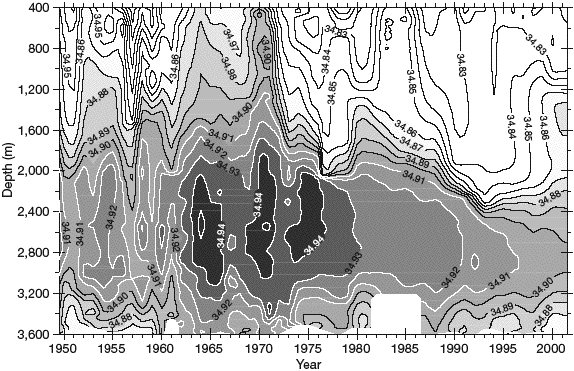
Salinity of the water of the central part of the Labrador Sea, depending on depth (vertical axis) and time (horizontal axis).
The decrease of the salinity at the bottom of the water column is clearly visible, and a possible hypothesis is the slowdown of the deep water formation, which is the descending part of the thermohaline circulation.
Source : Dickson & al., Nature, 2002.
- The second publication underlines that the flow of deep water going from the Norway Sea to the Atlantic seems to be presently decreasing :
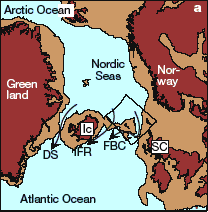
Deep water flux in the Nordic Seas
The deep water formation happens partly in the Norway Sea, between Greenland and Norway. The deep waters then flow to the Atlantic through various straits : between Greenland and Iceland, and between Iceland and Scotland (SC on the picture). Flows can be measured in those straits.
Source : Hansen & al, Nature, 2001
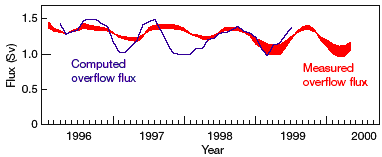
Flux of water below the 0.3 °C isotherm through the Faroe Bank channel (FBC on the left image).
The red curve is derived – with a little uncertainty, hence the width of the curve – from direct measurements (wth instruments moored in the channel) and the blue curve computed from other data.
The flow is showing a decreasing trend, estimated to be from 2% or 4% per year, depending on the assumptions, since the middle of the nineties.
Source : Hansen & al, Nature, 2001
- The third publication (Ramsdorf et al., Climatic Change, 1999) presents the results of a model that leads to a shutdown of the thermohaline circulation (in two centuries, still) with a relatively modest input of freshwater into the Northern Atlantic.
Is it likely to happen ?
The second way to discuss the hypothesis chosen by the Pentagon, now, is to wonder whether such a shutdown of the thermohaline circulation in 2020 is a “probable” outcome, that is an event with a significant risk of occurring associated with it.
The answer is here less pessimistic : the 3D models (said to be “atmosphere-ocean coupled models) do not show the beginning of shutdown of the thermohaline circulation with the climatic conditions predicted for 2020 (or even in 2100, see above). In other terms, the result obtained by Ramsdorf et al. does not reflect a consensus, for the time being, in the scientific community.
Here as elsewhere, all we can do is discuss on the grounds of the results of models. Indeed, the halts of the Gulf Stream that happened in the past (the last one 8000 years ago, see above) followed significant freshwater inputs to the surface of the Northern Atlantic, much more important than what we will most probably have in 2020. We therefore know (well scientists know !) that the threshold for such a shutdown is “somewhere” between the present climatic conditions and what happened 8000 years ago, but science does not allow, for the time being, to say exactly where that threshold stands. Furthermore, in the past the freshwater input has been the main modification for the Northern Atlantic, that did not undergo otherwise a previous warming like the one we are probably about to experience.
In order to establish as accurately as possible where the threshold stands for the future (and it is not said that we will manage to do so soon enough before the process starts, as the case may be) between the present conditions and a very different context that has never been experienced in the visible past, computer simulations are hard to substitute.
In conclusion, the most probable evolution is that the overturning will decrease a little until 2020, as most simulations suggest, but a brutal shutdown seems very unlikely. At last, a third level of discussion os to wonder wether the consequences envisioned by the document of the Pentagon are plausible if the Gulf Stream stops, be it in 2080 or in 2120 rather than in 2020. From this perspective, such an event happening anytime would probably be the start of a gigantic turmoil, including a massive mortality.
Incidentally, the interesting thing about this “report” is mainly that, coming from one of the agencies that Bush worships the most, it invites a president that often declared that he was skeptical on climate change to consider this evolution as a first rank menace for US national security. Still, there is one aspect of this report Bush would not disavow : there is not a single recommendation on the opportunity to reduce emissions!
Consequences for phytoplankton ?
The slowing down of convective marine currents could have another unpleasant consequence : as they are bringing from the oceanic depths the mineral elements (particularly iron) that are indispensable to the growth of plankton (of phytoplankton to be precise), on which the whole marine life of the open sea is based, and as these currents also play a significant role in the ventilation of the deepest layers, where they allow benthic life, their slowing down could harm marine life in a broad sense, and marine life does not necessarily need this additional contribution from us !
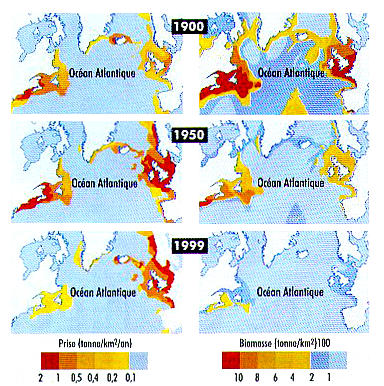
Estimation of the remaining biomass (right side) and of the annual captures (left side) in the Northern Atlantic in 1900, 1950 and 1999 (compilation of 23 different models).
Without any other modification, fishing has divided the marine biomass by ten in a century. Not bad…
Source : Science, 1999